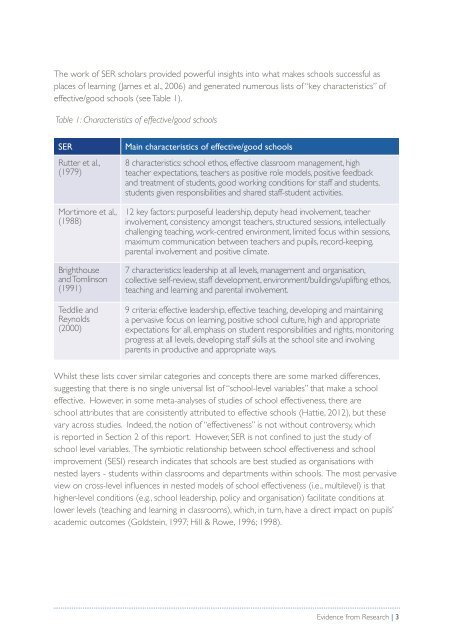Pearson-Exploring-Effective-Pedagogy-in-Primary-Schools
Pearson-Exploring-Effective-Pedagogy-in-Primary-Schools
Pearson-Exploring-Effective-Pedagogy-in-Primary-Schools
Create successful ePaper yourself
Turn your PDF publications into a flip-book with our unique Google optimized e-Paper software.
The work of SER scholars provided powerful <strong>in</strong>sights <strong>in</strong>to what makes schools successful asplaces of learn<strong>in</strong>g (James et al., 2006) and generated numerous lists of “key characteristics” ofeffective/good schools (see Table 1).Table 1: Characteristics of effective/good schoolsSERRutter et al.,(1979)Mortimore et al.,(1988)Brighthouseand Toml<strong>in</strong>son(1991)Teddlie andReynolds(2000)Ma<strong>in</strong> characteristics of effective/good schools8 characteristics: school ethos, effective classroom management, highteacher expectations, teachers as positive role models, positive feedbackand treatment of students, good work<strong>in</strong>g conditions for staff and students,students given responsibilities and shared staff-student activities.12 key factors: purposeful leadership, deputy head <strong>in</strong>volvement, teacher<strong>in</strong>volvement, consistency amongst teachers, structured sessions, <strong>in</strong>tellectuallychalleng<strong>in</strong>g teach<strong>in</strong>g, work-centred environment, limited focus with<strong>in</strong> sessions,maximum communication between teachers and pupils, record-keep<strong>in</strong>g,parental <strong>in</strong>volvement and positive climate.7 characteristics: leadership at all levels, management and organisation,collective self-review, staff development, environment/build<strong>in</strong>gs/uplift<strong>in</strong>g ethos,teach<strong>in</strong>g and learn<strong>in</strong>g and parental <strong>in</strong>volvement.9 criteria: effective leadership, effective teach<strong>in</strong>g, develop<strong>in</strong>g and ma<strong>in</strong>ta<strong>in</strong><strong>in</strong>ga pervasive focus on learn<strong>in</strong>g, positive school culture, high and appropriateexpectations for all, emphasis on student responsibilities and rights, monitor<strong>in</strong>gprogress at all levels, develop<strong>in</strong>g staff skills at the school site and <strong>in</strong>volv<strong>in</strong>gparents <strong>in</strong> productive and appropriate ways.Whilst these lists cover similar categories and concepts there are some marked differences,suggest<strong>in</strong>g that there is no s<strong>in</strong>gle universal list of “school-level variables” that make a schooleffective. However, <strong>in</strong> some meta-analyses of studies of school effectiveness, there areschool attributes that are consistently attributed to effective schools (Hattie, 2012), but thesevary across studies. Indeed, the notion of “effectiveness” is not without controversy, whichis reported <strong>in</strong> Section 2 of this report. However, SER is not conf<strong>in</strong>ed to just the study ofschool level variables. The symbiotic relationship between school effectiveness and schoolimprovement (SESI) research <strong>in</strong>dicates that schools are best studied as organisations withnested layers - students with<strong>in</strong> classrooms and departments with<strong>in</strong> schools. The most pervasiveview on cross-level <strong>in</strong>fluences <strong>in</strong> nested models of school effectiveness (i.e., multilevel) is thathigher-level conditions (e.g., school leadership, policy and organisation) facilitate conditions atlower levels (teach<strong>in</strong>g and learn<strong>in</strong>g <strong>in</strong> classrooms), which, <strong>in</strong> turn, have a direct impact on pupils’academic outcomes (Goldste<strong>in</strong>, 1997; Hill & Rowe, 1996; 1998).Evidence from Research | 3


